Canada 2014 "100th anniversary of the Royal Ontario Museum"
| <prev | back to index | next> |
| Issue Date | 14.04.2014 |
| ID | Michel: 3093-3094, Bl. 187; Scott: 2724a-b, 2724; Stanley Gibbons: ? , MS3022; Yvert et Tellier: 2970-2971, F2970; Category: pR |
| Design | Gerald Querubin, Entro Communications/Gottschalk+Ash, Toronto. Photographs were taken by ROM photographer Brian Boyle and the photo of the Michael Lee-Chin Crystal was taken by Tom Arban Photography Inc. |
| Stamps in set | 2 |
| Value | P - Archeologic and natural history artifacts P - Chinese statue and Parasaurolophus *P - Permanent TM - $0.85 per stamp is domestic letter rate |
| Emission/Type | commemorative |
| Places of issue | Toronto, Ontario (ON) |
| Size (width x height) | 32 mm x 40 mm, mini-sheet 122 mm x 70 mm |
| Layout | 10 stamps in a booklet, mini sheet of 2 stamps |
| Products | FDC x1, Mini-Sheet x1, Booklet x1, Postcards x3 |
| Paper | Tullis Russell Coatings paper |
| Perforation | 12,50 |
| Print Technique | Offset lithography |
| Printed by | The Lowe-Martin Group |
| Quantity | 150,000 |
| Issuing Authority | Canada Post |
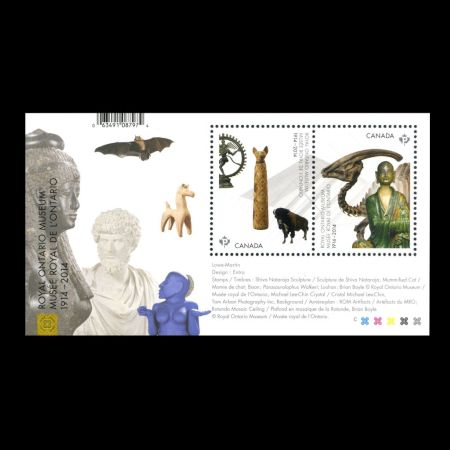
On April 14th, 2014 Canada's Post launched a booklet and souvenir sheet "100th anniversary of the Royal Ontario Museum (ROM)", showcasing notable museum artifacts.
The stamps feature carefully curated photographs of five of the ROM‘s most notable objects including: a Shiva Natajara Sculpture, a Mummified Cat dating back to 332-30 BCE, a skeleton of Parasaurolophus, and a Luohan Chinese sculpture from 11th-century and a Bison.
The artefacts represent the vastness of the Royal Ontario Museum’s (ROM) encyclopedic collection while the ROM’s Michael Lee-Chin Crystal featured on the stamp booklet cover and the background of the stamp represents the ROM’s continuing research and visionary future.
The Royal Ontario Museum (ROM) opened 100 years ago in 1914, but it was born earlier in the hearts and minds of two men. Sir Byron Edmund Walker – a banker, civic activist, art collector and amateur palaeontologist – was the driving force to establish a world-class museum in Toronto. Charles Trick Currelly was an adventurer and collector whose nose for artifacts laid the foundation of the ROM’s early collections.
Over the next century, the building and the collections would evolve into a world-renowned institution. Currelly’s story reads like that of a Canadian “Indiana Jones.” His interest in archaeology led him to explore the antiquities of Egypt, Crete and Asia Minor and record such far-flung adventures in a memoir. He was appointed the first director of the Royal Ontario Museum of Archaeology.
Since that time, the ROM has become a globally respected exhibition of world cultures and natural history. Each year, around a million visitors experience the wonder of the ROM. It's fascinating galleries, covering a wide range of topics in natural sciences and world civilizations, entertain, enlighten and inspire.
The museum contains notable collections of dinosaurs, minerals and meteorites, Near Eastern and African art, Art of East Asia, European history, and Canadian history.
It also houses the world's largest collection of fossils from the Burgess Shale with more than 150,000 specimens.
With six million artifacts and specimens to choose from, Entro designer Gerald Querubin and art director Doreen Colonello had some difficult decisions to make on the issue’s designs.
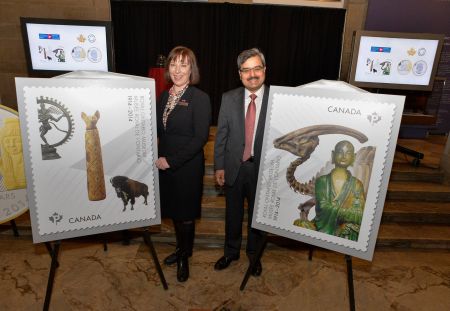 |
|
On April 15, Canada Post
President and CEO Deepak Chopra joined Janet Carding, Director and CEO,
Royal Ontario Museum, under the Rotunda at “the ROM” to unveil a new
stamp issue celebrating the museum’s 100th anniversary. Image credit: Newswire.ca, |
Designer Gerald Querubin adds, “The objects are part of the tradition and history of the ROM, while the Michael Lee-Chin Crystal architecture represents the ROM’s continuing research and visionary future.”
“For a century, the ROM has inspired learning for audiences around the world,” says the Honourable Lisa Raitt, Minister of Transport and responsible for Canada Post.
“This anniversary is the perfect opportunity to proudly pay tribute to these significant artefacts, and the renowned Museum they call home.”
“Over the past 100 years, the ROM has become a globally respected display of world cultures and natural history. ” says Deepak Chopra, Canada Post President and CEO. “Canada Post is pleased to join the ROM’s celebrations with this pair of stamps that showcase its vast diversity.”
“The ROM's year-long festival of Centennial celebrations highlight the many ways that the Museum connects visitors to their world and to each other.” says Janet Carding, Director and CEO, ROM.
Stand in the shadow of mighty T. rex… or underneath Gordo, the enormous Barosaurus… or beside our famous hadrosaur Parasaurolophus. No matter what the first stop on the dinosaur journey will be, visitors enter a gallery showcasing one of the world's best collections.
Hundreds of specimens welcome visitors to a gallery bursting with iconic and unusual dinosaurs, fossilized plants, insects and marine life. At the time dinosaurs lived, they shared the planet with other life on land, in the sea and in the air. Trace the development, relationships and legacy of all creatures that lived during the Age of Dinosaurs.
One of the dinosaurs exhibited in the ROM is incomplete, like most dinosaurs in the world, Parasaurolophus walkeri specimen.
Parasaurolophus is a genus of ornithopod dinosaur that lived in what is now North America during the Late Cretaceous Period, about 76.5–73 million years ago. It was a herbivore that walked both as a biped and a quadruped.
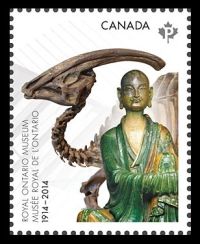 |
| Parasaurolophus walkeri and Luohan Chinese Sculpture on stamp of Canada from 2014, MiNr.: 3094, Scott: 2724b. |
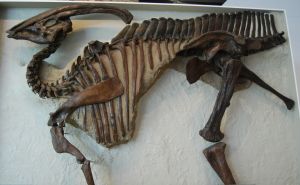 |
| Incomplete Parasaurolophus walkeri type specimen in the Royal Ontario Museum. Image credit: Wikipedia |
 |
| Parasaurolophus on "The World of Dinosaurs" stamp of USA 1997 MiNr.: 2822, Scott: 3136o. |
Parasaurolophus meaning "near crested lizard", is derived from the Greek para "beside" or "near", saurus "lizard" and lophos "crest". It is based on ROM 768, a skull and partial skeleton missing most of the tail and the hind legs below the knees, which was found by a field party from the University of Toronto in 1920 near Sand Creek along the Red Deer River in Alberta, Canada. These rocks are now known as the Campanian-age Upper Cretaceous Dinosaur Park Formation. William Parks named the specimen Parasaurolophus walkeri in honor of Sir Byron Edmund Walker, Chairman of the Board of Trustees of the Royal Ontario Museum. Parasaurolophus remains are rare in Alberta, with only one other partial skull from (probably) the Dinosaur Park Formation, and three Dinosaur Park specimens lacking skulls, possibly belonging to the genus. In some faunal lists, there is a mention of possible Parasaurolophus walkeri material in the Hell Creek Formation of Montana, a rock unit of late Maastrichtian age. This occurrence is not noted by Sullivan and Williamson in their 1999 review of the genus, and has not been further elaborated upon elsewhere.
Another gallery with some fossils of prehistoric animals of the museum is The Reed Gallery of the Age of Mammals explores the rise of mammals through the Cenozoic Era that followed the extinction of the dinosaurs. There are over 400 specimens from North America and South America on display. Also included in the gallery are, 30 fossil skeletons of extinct mammals, over 160 non-mammalian specimens, and hundreds of fossil plants, insects, fish, and turtles. The gallery's entrance begins with mammals that arose shortly after the extinction of the dinosaurs. A highlight of this gallery is the sabre-toothed nimravid Dinictis.
Products and associated philatelic items
| FDC (clean and posted to Germany) | Booklet of self adhesive stamps | |
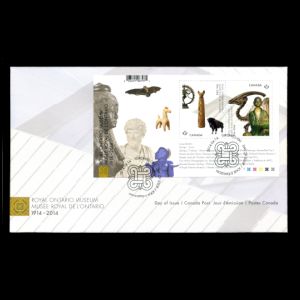 |
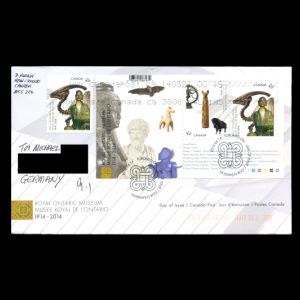 |
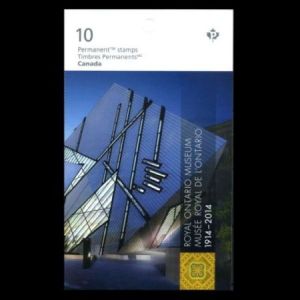 |
| Both outsides are here, Inside is here. | ||
| Example of circulated covers with the Mini-Sheet | Postcards | |
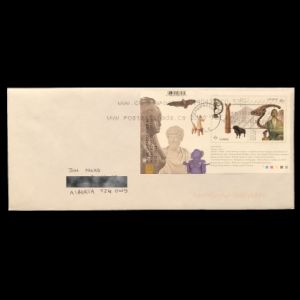 |
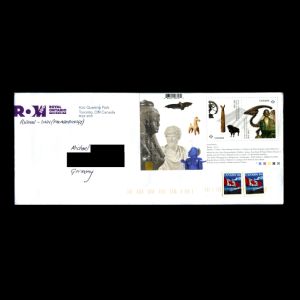 |
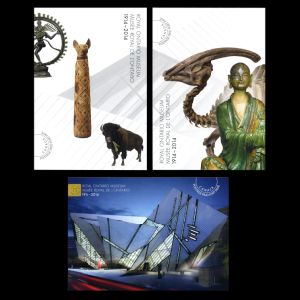 |
| The cover posted from the ROM museum to Germany, but no stamp was cancelled. The only evidence, the cover is circulated in the track of letter sorting machine on the bottom. | Reverse side of clean postcards are here, Reverse side of circulated postcards are here. | |
| Example of circulated covers with Mini-Sheet and self-adhesive stamps from the booklet | ||
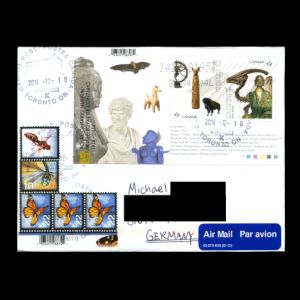 |
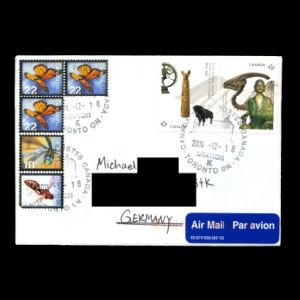 |
|

|
- Technical details and description of the stamps:
"Details" magazine of Canada's Post, No. 3, April 2014; NewsCanada Plus; Newswire.ca, Canada Post, stampcommunity.org. colnect. - The Royal Ontario Museum (ROM): official website, Wikipedia.
- Parasaurolophus: Encyclopedia Britannica. Wikipedia.
Acknowledgements:
Many thanks to Dr. Peter Voice, PhD Department of Geological and Environmental Sciences, Western Michigan University, USA, for review of a draft of this article.
| <prev | back to index | next> |